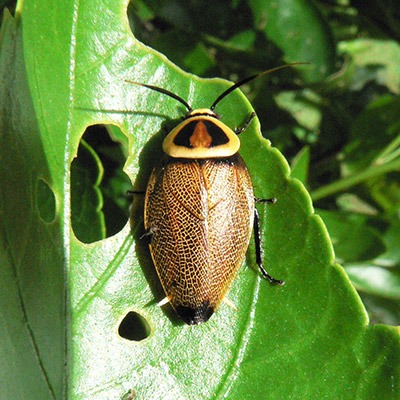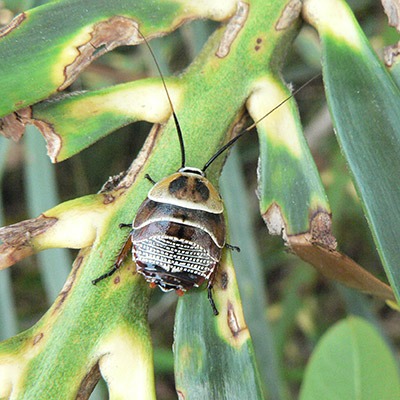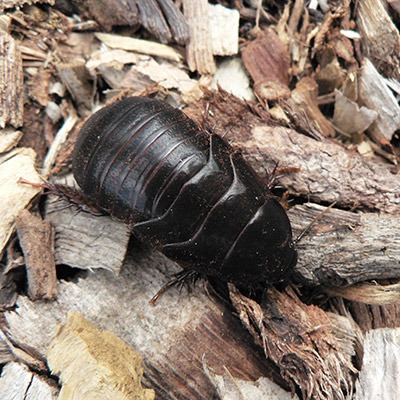See our other cockroach fact sheets
Giant Burrowing Cockroach
Australian Cockroach
Cockroaches (Blattodea)

Description:
Cockroaches are one of the oldest insects on the planet. Fossils of cockroaches have been found that date back to over 350 million years ago! There are approximately 4000 species of cockroaches throughout the world, but only around 30 of these are pests. Most cockroaches live in trees or underground and don’t come into our houses like the pesky ones. Cockroaches prefer warm, moist sub-tropical climates, but can be found almost everywhere in the world where humans dwell. Cockroaches range in size from 3mm – 65mm, with flattened oval shaped bodies and long spiny legs for running or digging. While most cockroaches are brown, they also come in shades of yellow, black and even bright colours like green, blue and red!
Life Cycle:
Most cockroaches lay their eggs in a protective capsule called an ootheca. These can be buried, glued to a flat surface, scattered loosely on the ground or held within the female’s abdomen until they hatch. Cockroaches can breed very quickly, especially in warmer climates. Some females can produce an ootheca every 3 days, resulting in a whopping 500-700 eggs in their lifetime! Young cockroaches or nymphs look exactly like their parents, only smaller and without wings. They take around 4-6 months to reach adulthood (although some species can take over a year).
Favourite foods:
Some cockroaches are strict vegetarians and will only eat leaves. Other cockroaches are scavengers and can eat just about anything. The pest cockroaches that invade our homes usually forage around on the ground at night eating scraps of food. But they have been known to eat leather, rubber, paper, foam and even engine oil!


Defence tactics:
When threatened by a predator (or us trying to spray them or squash them with our shoe) a cockroach will run. And boy can they run! Some cockroaches can cover up to 50 body lengths in a single second! Our fastest athletes can only get up to around 5 or 6 body lengths in the same amount of time. The reason cockroaches can run so fast is a little pair of peg-like structures at the end of their abdomen called cerci. Cerci are very sensitive and can pick up tiny changes in air currents, so a cockroach can feel you moving towards them before they can even see you. The cerci send messages directly to their legs to start running. Humans have to send a message firstly to their brain and then back to their legs, which explains why cockroaches are much faster to react than us.
Fascinating Facts:
- Some cockroaches have a small suction cup between the claws on the last segment of each leg. This pad automatically inflates like an air-bag, allowing them to grip to very slippery surfaces. This means a cockroach can climb up glass, tiles, shower screens and the sides of a bath tub with ease.
- Some cockroaches can live for 4-6 weeks without a head! Cockroaches have a large nerve centre in each segment of their bodies (head, thorax and abdomen). If you eliminate one, the other two will still keep working, which means a cockroach can survive without a head. Apart from bumping into things (you can’t see where you’re going if you don’t have a head!), the cockroach will continue to lead a normal life until it eventually dies from starvation (its hard to eat anything if you don’t have a head)!
Click on the links below to learn more about cockroaches found in Australia.
Giant Burrowing Cockroach
Australian Cockroach
